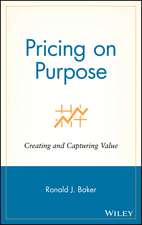Implementing Value Pricing – A Radical Busine ss Model for Professional Firms + Website: Wiley Professional Advisory Services, cartea 08
Autor RJ Bakeren Limba Engleză Hardback – 24 ian 2011
Praise for IMPLEMENTING VALUE PRICING
A Radical Business Model for Professional Firms
"Ron Baker is the most prolific and best writer when it comes to pricing services. This is a must-read for executives and partners in small to large firms. Ron provides the basics, the advanced ideas, the workbooks, the case studies—everything. This is a must-have and a terrific book."
—Reed K. Holden founder and CEO, Holden Advisors, Corp., Associate Professor, Columbia University www.holdenadvisors.com
"We've known through Ron Baker's earlier books that he's not just an extraordinary thinker and truly brilliant writer—he's a mover and a shaker on a mission. This is the End of Time! Brilliant."
—Paul Dunn Chairman, B1G1® www.b1g1.com
"Implementing Value Pricing is a powerful blend of theory, strategy, and tactics. Ron Baker's most recent offering is ambitious in scope, exploring topics that include economic theory, customer orientation, value identification, service positioning, and pricing strategy. He weaves all of them together seamlessly, and includes numerous examples to illustrate his primary points. I have applied the knowledge I've gained from his body of work, and the benefits to me—and to my customers—have been immediate, significant, and ongoing."
—Brent Uren Principal, Valuation & Business Modeling Ernst & Young® www.ey.com
"Ron Baker is a revolutionary. He is on a radical crusade to align the interests of service providers with those of their customers by having lawyers, accountants, and consultants charge based on the value they provide, rather than the effort it takes. Implementing Value Pricing is a manifesto that establishes a clear case for the revolution. It provides detailed guidance that includes not only strategies and tactics, but key predictive indicators for success. It is richly illustrated by the successes of firms that have embraced value-based pricing to make their services not only more cost-effective for their customers, but more profitable as well. The hallmark of a manifesto is an unyielding sense of purpose and a call to action. Let the revolution begin."
—Robert G. Cross, Chairman and CEO, Revenue Analytics, Inc. Author, Revenue Management: Hard-Core Tactics for Market Domination
Preț: 533.89 lei
Preț vechi: 667.37 lei
-20% Nou
102.17€ • 106.28$ • 84.35£
Carte disponibilă
Livrare economică 25 martie-08 aprilie
Livrare express 08-14 martie pentru 35.25 lei
Specificații
ISBN-10: 0470584610
Pagini: 400
Ilustrații: Illustrations
Dimensiuni: 162 x 233 x 28 mm
Greutate: 0.6 kg
Editura: Wiley
Seria Wiley Professional Advisory Services
Locul publicării:Hoboken, United States
Public țintă
All leaders, managers, executives, marketing, finance, and pricing professionals in the finance sectorCuprins
Foreword. Preface. About This Book. About the Web Site. About the Words Used in This Book. Acknowledgments. About the Author. PART I A RADICAL BUSINESS MODEL. Chapter 1 The Firm of the Past. Chapter 2 The Firm of the Future. The Business Model of the Firm of the Future. Revenue Is Vanity--Profit Is Sanity. Businesses Have Prices, Not Hourly Rates. Why Intellectual Capital Is the Chief Source of Wealth. Negative Intellectual Capital. Why Effectiveness Trumps Efficiency. What, Exactly, Is Productivity? There's No Such Thing as Generic "Efficiency." Where do Profits Come From? If Only I Knew Then What I Know Now. Summary and Conclusions. PART II FOUNDATIONS OF CREATING VALUE. Chapter 3 Why Are We in Business? The Economist's Definition of Profit. The Marketing Concept and Total Quality Service. Summary and Conclusions. Chapter 4 A Tale of Two Theories. The Labor Theory of Value. Karl Marx, False Prophet. The Marginalist Revolution of 1871. Why Are Diamonds More Expensive Than Water? Wrong Theory, Suboptimal Results. Chapter 5 Four Ps and Five Cs. The Five Cs of Value. You Are What You Charge. Chapter 6 What People Buy. The Dynamics of Customer Expectation. Chapter 7 How People Buy. Relative, Not Absolute, Price Matters. Price Psychology. Search, Experience, and Credence Attributes. Understanding Customer Risk. The Four Ways to Spend Money. Chapter 8 Your Firm's Value Proposition. Moments of Truth. What Is Beyond Total Quality Service? Chapter 9 The Consumer Surplus and Price Discrimination. Price Elasticity. Consumer Surplus. Price Discrimination. Requirements to Price Discriminate. Chapter 10 Macro Pricing Strategies. Skim Pricing. Penetration Pricing. Neutral Pricing. Two More Curves for Value. Implications of the Curve. Chapter 11 Price the Customer, Not the Service. Ten Factors of Price Sensitivity. Chapter 12 There Is No Such Thing as a Commodity. The Perils of Benchmarking. Purging the Commodity Word. Chapter 13 Baker's Law: Bad Customers Drive Out Good Customers. Customer Grading Criteria. The Adaptive Capacity Model. Firing Customers. The Forced Churn. Chapter 14 Value Pricing and Self-Esteem. There Is No Standard Price for Intellectual Capital. Chapter 15 Ethics, Fairness, and Value Pricing. The Morality of Price Discrimination. Prospect Theory. Is Hourly Billing Ethical? PART III THE GENESIS AND CONSEQUENCES OF HOURLY BILLING AND TIMESHEETS. Chapter 16 A Brief History of Hourly Billing and Timesheets. The Father of the Billable Hour and Timesheet--in the Legal Profession. Summary and Conclusions. Chapter 17 The Deleterious Effects of Hourly Billing. The Advantages of Hourly Billing. What about the Customer? The Disadvantages of Hourly Billing. Summary and Conclusions. PART IV WHAT REPLACES HOURLY BILLING AND TIMESHEETS. Chapter 18 Why Carthage Must Be Destroyed. What, Exactly, Replaces Hourly Billing and Timesheets? Chapter 19 Price-Led Costing Replaces Hourly Billing. Wisdom Is Timeless. Summary and Conclusions. Chapter 20 The Wrong Mistakes. The Almighty Hourly Rate. Making the Wrong Mistakes. Chapter 21 Who Is in Charge of Value? The World's First CVO. Leadership. Attitude. Commitment. Experimentation. Youth. Not Final Thoughts. Chapter 22 Measure What Matters to Customers. The McKinsey Maxim. Developing a Theory. Pantometry versus Theory. A Gedanken. Chapter 23 Firm-wide Key Predictive Indicators. KPIs for a Professional Knowledge Firm. KPIs Equal Customer Accountability. Chapter 24 Knowledge Worker Key Predictive Indicators. A Model for Knowledge Worker Effectiveness. Key Predictive Indicators for Knowledge Workers. Chapter 25 After Actions Reviews. We Know More Than We Can Tell. The Economics of Structural Capital. Knowledge Lessons from the U.S. Army. Summary and Conclusions. Chapter 26 O'Byrne & Kennedy: A Firm of the Future. PART V EIGHT STEPS TO IMPLEMENTING VALUE PRICING. Chapter 27 The Eight Steps at a Glance. Three Different Kinds of Problems. Eight Steps to Implementing Value Pricing. Chapter 28 Step One: Conversation. The Conversation. Naïve Listening. Focus on Wants, Not Needs. Starting the Conversation. Conversations Lower Asymmetrical Information and Adverse Selection. Questions You Should Ask the Customer. Ordinal Value, Not Cardinal Value. Discussing Risk with the Customer. Summary and Conclusions. Chapter 29 Step Two: Pricing the Customer: Questions for the Value Council. Questions to Ask before Establishing a Price. Factors for Price Sensitivity. Pricing Questions. Chapter 30 Step Three: Developing and Pricing Options. The Psychology of Price. Seven Generic Customer Segmentation Strategies. Pricing Options. Pricing Complex Projects. FORD--A Model for Consulting. Dipping Your Toe in the Water. Formula for Calculating Reservation Price. Summary and Conclusions. Chapter 31 Step Four: Presenting Options to the Customer. Handling Price Objections. Summation: Presenting Your Price to the Customer. Chapter 32 Step Five: Customer Selection Codified into the Fixed Price Agreement. Date of the FPA. Professional Services. Unanticipated Services. Service and Price Guarantee. Payment Terms. Revisions to the FPA. Termination Clause. Other Issues Regarding the FPA. Chapter 33 Step Six: Proper Project Management. Chapter 34 Step Seven: Scope Creep and Change Orders. Chapter 35 Step Eight: Pricing After Action Reviews. PART VI INFLECTION POINT. Chapter 36 No One Can Forbid Us the Future. Business Model Innovation. The Diffusion of Theories. Firm of the Future or Firm of the Past? Chapter 37 Declaration of Independence. Bibliography. Index.





























